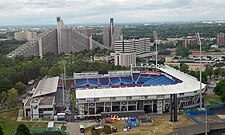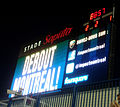Saputo Stadium
| File:Stade Saputo logo.png | |
 Saputo Stadium in 2012 | |
 | |
| Address | 4750 Sherbrooke Street E |
|---|---|
| Location | Montreal, Quebec |
| Coordinates | 45°33′47″N 73°33′9″W / 45.56306°N 73.55250°W |
| Public transit | Montreal Metro (STM): Lua error: expandTemplate: template "AMT color" does not exist. |
| Owner | Saputo Inc. |
| Operator | Montreal Impact |
| Capacity | 20,801[5] |
| Field size | 120 by 77 yards (110 m × 70 m)[5] |
| Surface | Grass |
| Construction | |
| Broke ground | April 18, 2007 |
| Opened | May 18, 2008 |
| Expanded | June 16, 2012 |
| Construction cost | C$47 million[1][2][3] |
| Architect | Zinno Zappitelli Architectes (2008); Provencher Roy + Associés Architectes (2012) |
| Services engineer | CIMA+ Engineering[4] |
| General contractor | Broccolini Construction Inc. |
| Main contractors | Dant Clayton Corporation |
| Tenants | |
| Montreal Impact (MLS) (2012–present) Montreal Impact (NASL) (2008–2011) Montreal Impact U23 (PDL) (2014) Montreal Impact Academy (CSL) (2010-2012) Canada men's national soccer team (2008–2010) FC Montreal (USL) (2015–2016) | |
Saputo Stadium (French: Stade Saputo) is a soccer-specific stadium at Olympic Park in Montreal, Quebec, Canada. The stadium opened on May 21, 2008, and is the current home of the Montreal Impact. The stadium is built on the former practice track and field site on the grounds of the 1976 Summer Olympics, while the stadium's east side has a view of Olympic Stadium's inclined tower. It has a capacity of 20,801,[5] making it the second-largest soccer-specific stadium in Canada, after BMO Field in Toronto.
Construction
The stadium cost CA$17 million ($23.4 million in 2023 dollars)[6] to build, with $7.5 million paid by the Saputo family and the rest financed on a 25-year term.[7] Saputo Stadium is now the Impact's administrative headquarters and also includes a training field, 34 corporate suites and full player welfare areas. The complex covers approximately 1,600,000 square feet (150,000 m2). It was designed and fabricated by Dant Clayton Corporation and built by Broccolini Construction Inc.
The stadium features a natural grass playing surface and was reportedly preferred over BMO Field for this reason by members of the Canada men's national soccer team.[8] BMO Field has since installed a heated and fully irrigated natural grass field similar to those found in the English Premier League.
Anticipating a Montreal entry into Major League Soccer, plans were made to expand the stadium from its initial 13,034 capacity to 20,000 to cope with the anticipated boost in attendance.[9][10] The Quebec government put $23 million for the renovation and expansion of the stadium (the total cost of the stadium was therefore about $40 million). The construction plans went into effect after MLS granted Montreal their nineteenth franchise, which began play in the 2012 season.[11]
Sports usage
The stadium welcomed its first Impact home game on May 19, 2008, a scoreless draw against the Vancouver Whitecaps. The Impact's first goal in the stadium was scored by Rocco Placentino against the Charleston Battery on June 13, 2008. This also gave the Impact its first victory in the stadium, with a score of 1–0. The Impact's first game in the newly renovated and expanded Saputo was played on June 16, 2012 against the Seattle Sounders FC. The Impact won the game 4–1.
The first international at Saputo Stadium was the second leg of Canada's second stage CONCACAF World Cup Qualifying match on June 20, 2008.[12]
Gallery
This section contains an unencyclopedic or excessive gallery of images. |
-
View inside the stadium prior to expansion
-
Saputo Preferential Tribune prior to expansion
-
Saputo Stadium at night prior to expansion
-
Stadium in 2010 prior to expansion
-
Home match against New York Red Bulls in 2012
-
Goal celebration against D.C. United in 2012
-
Stadium in July 2012 after expansion
-
Scoreboard of Saputo Stadium
See also
References
- ^ C$40 million = C$17 million (2008 opening) + C$23 million (2012 expansion)
- ^ Philipps, Randy (June 3, 2012). "Saputo Stadium renovations will be "marathon" until June 16, Impact boss says". The Gazette (Montreal). Archived from the original on June 4, 2012. Retrieved June 18, 2012.
{{cite news}}: Unknown parameter|deadurl=ignored (|url-status=suggested) (help) - ^ Dubuc, Andre (February 13, 2013). "Le stade Saputo a coûté 30% de plus que prévu". La Presse(Montreal). Retrieved February 13, 2013.
- ^ "CIMA+ Engineering". Cima.ca. Retrieved July 20, 2012.
- ^ a b c impactmontreal.com - Stade Saputo Archived March 14, 2015, at the Wayback Machine
- ^ 1688 to 1923: Geloso, Vincent, A Price Index for Canada, 1688 to 1850 (December 6, 2016). Afterwards, Canadian inflation numbers based on Statistics Canada tables 18-10-0005-01 (formerly CANSIM 326-0021) "Consumer Price Index, annual average, not seasonally adjusted". Statistics Canada. Retrieved April 17, 2021. and table 18-10-0004-13 "Consumer Price Index by product group, monthly, percentage change, not seasonally adjusted, Canada, provinces, Whitehorse, Yellowknife and Iqaluit". Statistics Canada. Retrieved May 8, 2024.
- ^ "Stade Saputo Expansion". www.impactmontreal.com. Archived from the original on March 14, 2015.
{{cite web}}: Unknown parameter|deadurl=ignored (|url-status=suggested) (help) - ^ Campbell, Morgan (September 18, 2008). "Natural Grass 'Not Hot on Radar' for BMO Field". The Toronto Star. Retrieved September 18, 2008.
- ^ Montréal se joint à la MLS en 2012 (May 7, 2010).
- ^ Daigle, Frédéric (May 7, 2010). "Joey Saputo: Montréal aura enfin le soccer qu'il mérite". La Presse Canadienne.
- ^ Freedman, Jonah (May 7, 2010). ""Passionate" Montreal named as 19th MLS city". MLSSoccer.com. Retrieved May 7, 2010.
- ^ "Saputo Stadium to host Canada's World Cup qualifier". TSN.ca. April 22, 2008. Retrieved March 12, 2012.
External links
| Preceded by Complexe sportif Claude-Robillard 1993—2007 |
Home of the Montreal Impact 2008—2011 |
Succeeded by current (in MLS) |
| Preceded by Olympic Stadium |
Home of the Montreal Impact (MLS) 2012—present |
Succeeded by current |








